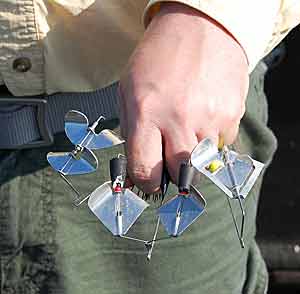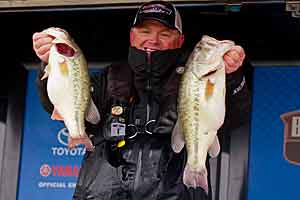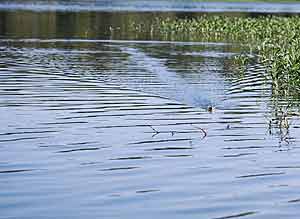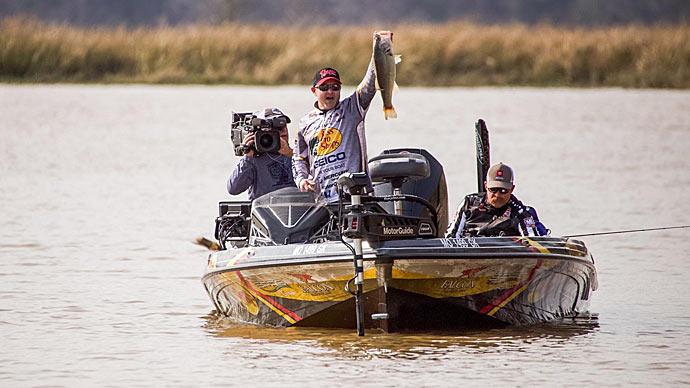
“In some lakes, it seems the bass are born looking up.” That was the explanation my fishing partner gave to me as we idled back to a small ramp on the southern end of Lake Champlain. I had thrown buzzbaits before and caught some bass on them. But this day, it was action all day long for both of us. Summer had settled on the more than 100-mile long lake that splits New York and Vermont. Laydowns, milfoil, and bulrushes lined the small creek where we started and most of the spots we ran the rest of the day. Each seemed to be filled with largemouth bass. We steadily retrieved our buzzbaits through and next to each piece of cover. Many times, as soon as it gurgled past, a swirl would appear, and the rod would load from the weight of a thick bass.
Topwater fishing is fun because you see the strike. And those strikes can come at any moment during your retrieve, which adds anticipation and excitement. Often strikes seem to come when you’re not looking at your lure. That seems to happen so often that some anglers purposely look away from every cast, hoping to bait the bass gods into smiling down with a strike. There are endless varieties of topwater lures: Walkers, poppers, twitch baits, frogs, toads, and prop baits are just some of them. One that has seen its spotlight fade is the buzzbait. It came on the scene as bass fishing — especially tournament fishing — blossomed in the 1970s. It is a simple lure built with a paddlewheel blade, spinnerbait-like frame, and multistrand skirt. Even an inline version — arranged like a trout spinner — shines brightest in heavy vegetation. That simplicity crosses over to how a buzzbait is fished. It only needs a steady retrieve to keep it churning the surface. The only adjustments you can make are speeding it up or slowing it down. All others are made to the lure itself.
The blades distinguish buzzbaits from each other. Sure, they come in every color under the sun, and sometimes a dogleg is bent into the wire frame between the line tie and the head, so the hook rides lower, giving bass a better chance of eating it. But their action comes from their blades. They lift them to the surface, create sound and determine how much they disturb the surface. The baseline buzzer has a single flat blade, and its tips are turned in to catch water. Variations take off from there. The single blades can be stacked, one in front of the other. Some have more wings, becoming three- and four-bladed buzzbaits. Others have single blades that have their center removed. Inside, a smaller counter-rotating blade with any number of wings is added.
The additional blades increase sound and commotion. They also add lift, helping the lure climb to the surface faster at the beginning of the retrieve and allowing it to be fished slower.
There is one style of buzzbait that does that exceptionally well. It goes by several nicknames and flies under many anglers’ radars, but the side-by-side blade configuration is gaining tackle box space. It first hit the mainstream market about 20 years ago, when Roland Martin put his name on a Blue Fox version, but it never displaced the popularity of any single-blade models. Side-by-side buzzers continued to arrive at tackle shops, including one built by Indianapolis-based Accent Tackle. Its High Rider B-2 buzzbait is easily recognizable because of the small foam that floats behind each blade. Shane Lineberger, a Lincolnton, N.C., bass angler who competes in the Bassmaster Opens along with a smattering of local events, prefers the Tar Heel-made Twin-V Buzzbait, which Monroe, N.C.-based TrueSouth Custom Lures, makes. “It catches the right fish,” he said. “It has a sound of its own. Sometimes the blades clack, and it has a high-pitch sound.” He keeps his selection simple. He uses the 3/8-ounce size. As far as colors, he ties on a black one when the water is clear and a white one when it’s dirty.
Some buzzbaits sport one additional variation — a clacker. It’s a free-swinging metal flapper that hangs above the line tie. The blade smacks it each revolution, making the clacking sound derived from its name. It draws a bass's attention in certain situations, such as extremely muddy water or thick vegetation. When the cover is sparse or water clear, it can be a deterrent, spooking bass. It also can draw unwanted attention during a tournament. That exact situation happened on North Carolina’s Lake Wylie late last fall. It was immediately apparent what the competitor, almost out of sight at the other end of the creek, was throwing without seeing it. The rhythmic clack that his buzzbait made carried across the water and echoed off the boathouses.

During the summer, Lineberger always rigs a buzzbait on at least one rod. The water temperature dictates how much he throws it during the day as it becomes warmer, and the buzzbait window narrows. When the water is at its warmest — summer surface temperatures in the mid-90s are common in his neck of the woods — the first 35 or 40 minutes in the morning might be the only time bass will chase one. The window remains closed in the evening because water is slow to cool, needing an entire night to drop enough to move bass shallow. When the temperature is right, he’ll throw it all day, especially when it’s cloudy. He starts with a fast retrieve key to generate a reaction strike whenever he throws it. An argument can be made that a buzzbait looks like a couple of shad or even a frog sliding along the surface, but no one knows. In the end, the commotion draws the bass to it, and the speed makes it bite immediately or lose what may be a meal forever. If the daily conditions put bass in a conservative mood and cause them to miss a buzzbait, he will slow the retrieve until he finds the speed they want.
The angler is usually to blame when a bass blows up on a buzzbait but isn’t hooked. It’s natural to swing a hook set the instant a blowup happens. Self-control is needed when fishing buzzbaits, and there are ways to build it into your approach.
“A lot of times, they’ll blow up on it two or three times,” Lineberger said. “You have to wait for the rod to load up.” A slower-action rod, such as a heavy power cranking rod, helps. It can move bass from line-snapping shallow cover, and its parabolic bend needs time to load during a hook set. You can hit them with one as soon as you see the swirl because there will be a delay before it moves the buzzbait way out on the end of your line. Spooling a high-speed reel with 15- to 20-pound test monofilament line will help, too. A faster reel will get the bait to the surface sooner, and the monofilament line, which floats, unlike fluorocarbon, offers something that braid can’t — stretch. That also dulls the effects of a lightning-fast hook set.
You can also modify a buzzbait that will lead to a better hook-up ratio. The first is making the lure compact by trimming the skirt so it’s no more than 1 inch behind the hook. While popular on spinnerbaits, soft-plastic trailers aren’t needed on buzzbaits. Lineberger doesn’t run one, but he does add a trailer hook. You want the trailer hook to hang straight behind the main hook to keep it from snagging the cover. The best way to ensure that happens is by discarding the rubber “keeper” that many lure-makers use to hold the trailer hook. More often than not, it kicks and then holds the hook out to the side. Instead, put the trailer hook on and then, using a pair of needle-nose pliers, tighten its eye, so it’s smaller than the barb on the main hook but big enough to allow it to swing freely.

Even with all that, some bass will still be missed. Those you can blame on the bass, though there are still ways to catch them. One thing you can’t do is stop your retrieve. That kills the action that initially drew the bass and sends your buzzer to the bottom. You can have a second rod rigged with a lure that you can throw back in after you’ve raced the buzzer back.
“I like to use a jig,” Lineberger said. “You can throw it back in where you saw the strike and most times watch the line swim off.” Other “throw-back” lures choices include worms or flipping baits, such as creatures. Soft stickbaits also are popular. Their slow, undulating fall gives bass more time to circle back and find it. The most important thing, though, is not to give up. That bass is ready to attack and revealed its exact location, so go back after it.
Another option is to make your buzzbait more subtle. You can downsize to a lightweight 1/8-ounce one with a tiny blade or switch to a soft-plastic toad such as a Stanley Ribbit. These baits are rigged Texas-style and use the same steady retrieve as buzzbaits. Their little paddle feet kick up the surface like a buzzbait but are more muted in sound and disturbance. When bass stop eating a buzzbait, these often keep drawing strikes.
Lineberger likes to tuck his boat against the bank when he fishes a buzzbait. Once there, he’ll make long casts that parallel the bank. He’ll line up his retrieves, so they cross shallow structure or pieces of cover. Seawalls, riprap, and floating docks are some of his favorite targets. High water helps his attack, which was the case early last summer on his home lake, Norman. That additional depth kept more bass on shallow targets. Attacking the water like the way Lineberger does keeps you buzzbait in the strike zone longer. For example, you can line up the corner of a seawall, mooring float and several dock posts on one cast, increasing the number of ambush spots your lure passes. The same can be done on weed-filled natural lakes, but there might be a point of bulrushes, a portion of an inside weedline, and a patch of lily pads.
Buzzbaits don’t always have to be fished near shore or in shallow enough water to wade. When hot summer temperatures push bass deep, they’ll still use the shallow edges of the main-lake structure at times. The tops of shoals or the end of long points, especially those near the main river channel, can be perfect for buzzbaits. Floating docks are a prime target, too. Often strung together and anchored in depths of 30 feet or more, summertime bass will suspend under them. Strikes can be drawn by running a buzzbait along the floats or between a docked boat and the floats.
The end of summer doesn’t mean the end of buzzbait success. As temperatures cool, the window opens wider, and bass will hit them almost all day, especially when it’s cloudy. Lineberger keeps throwing his buzzbait until the water temperature drops to the low 60s. Fall also is when fishing in the river portions of Southern impoundments turns on. Buzzbaits are built for quickly exploring the main river and backwater spots. They also make an excellent alternative to the crankbaits, spinnerbaits others are throwing at schooling bass.
That summer day on Lake Champlain was a classic fishing day: fun partner, fast action, and fantastic weather. The buzzbait shined, allowing us to cover water, take advantage of active bass, and whoop and holler every time one made a swirl the size of a manhole cover. Those are why buzzbaits need to be essential to your approach. They might not be the most technically advanced lure or have the flashiest patterns, but they catch lots of big bass.




